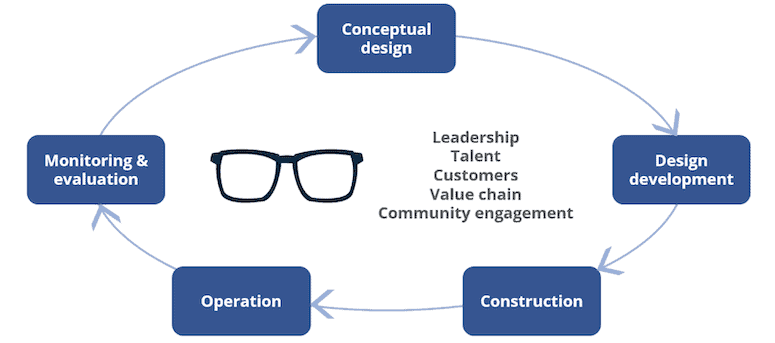A Gender-Smart Renewable Energy Transition: Why Climate Change Solutions Can’t Overlook Inequality
With only eight years left to achieve the 2030 Agenda for Sustainable Development, we in the global development community must ask ourselves what progress has truly been made. The 17 Sustainable Development Goals that categorized pressing social and environmental problems recognize gender equality (SDG 5) and affordable and clean energy (SDG 7) as imminent priorities. Yet today, the climate crisis is no longer on the horizon but rather a reality. And while gender equality is widely recognized as indispensable for economic and social development, women business leaders, employees, policymakers, customers and beneficiaries have been left out of the conversation in the clean energy transition.
We are running out of time to meaningfully change course. We must address the gender inequalities of the energy sector to achieve our goals of mitigating climate change and building a more sustainable future for all. Likewise, inclusive climate change solutions will advance gender equality. In fact, no single SDG can be achieved without the integration of a gender and climate perspective. By integrating these dual urgencies of our time, we have the opportunity to accelerate social and environmental impact while enhancing the economic and investment performance of energy projects.
Climate Change is a Gendered Issue
Considering the differentiated roles that society imposes on women and men, it should be of no surprise that energy generation, access and consumption are highly unequal. Women are more likely to live in poverty and have reduced access to energy sources. To a large extent, women also spend more time and effort accessing energy services for the family, generating what we call time poverty, as women work longer days than men on average when accounting for all their unpaid domestic work. Additionally, while energy access is largely expected to improve quality of life, one study found that it is generally men and to some extent children who benefit most. For women, electricity after dark often means extending the workday – and therefore the time they must spend on unpaid labor. It is increasingly apparent that no meaningful advances can be made toward the goal of affordable and clean energy without considering gender equality.
While this approach can provide a compelling opportunity for social impact, it’s also important to understand why it matters for business. It has become clear that integrating a gender perspective into energy projects is good for business. For one, investors are increasingly seeking – and in some cases even requiring – companies and projects to incorporate and act on gender considerations as a part of the investment. One report estimated that by the end of 2020 there were over $18 billion in assets managed by gender lens investment vehicles across both public and private markets, demonstrating on average more than 200% year-over-year growth between 2017-2020. And investors across the spectrum are starting to require gender assessments and impact reports, as pressure from the ecosystem grows.
Additionally, just as climate change poses risks to every company in every sector, so does gender inequality. Internal risks, such as sexual harassment, and external risks, such as community unrest driven by inequality, can disrupt operations and affect the bottom line. Last but certainly not least, diversity is time and again shown to have outsized positive effects on financial performance, with institutions such as McKinsey showing that companies in the top quartile for gender diversity on executive teams were 25% more likely to have above-average profitability than companies in the lowest quartile. The energy sector is no exception.
It’s clear that the goal of affordable and clean energy for all will be accelerated by the equitable participation of women in the sector. But how can the industry move toward greater inclusion and empowerment of women?
Where and how do gender and energy meet?
Terms such as “gender blind” or “gender neutral” have become commonplace, but we now know that in the energy sector, as in other industries, this approach is not only insufficient, it can also be harmful. Failing to recognize the different roles and responsibilities that society imposes on different genders – and how that affects the business environment – not only perpetuates gender inequalities, it also causes energy companies and developers to miss out on important market and financial opportunities.
Instead, it’s important to move toward a different approach, best described as “gender smart,” in which we use a new set of lenses to identify the gendered dimensions that are present across the lifecycle of energy projects or enterprises. Initially, this approach requires us to take a broad perspective that considers the many roles that women play in the energy sector – both internally and externally – as leaders, employees, customers, suppliers and community members. Subsequently, we can consider each of these roles at each stage of the project or business’ life cycle, and how they impact activities ranging from conceptual design and development, to construction, operation, and monitoring and evaluation.

For example, it is no secret that women are underrepresented in this sector. While research varies, it is estimated that women hold around 32% of jobs in the renewable energy space. Within the jobs they occupy, they are much more likely to be employed in administrative and non-technical positions, which also have lower wages. It is also clear that this gender gap starts even before women enter the workforce, considering women represent only 35% of STEM students in higher education worldwide. One particularly worrying aspect of this persistent gap is that renewable energy is one of the fastest-growing sectors, and is expected to generate 42 million jobs by 2050 – four times its 2020 level. And yet these jobs are not equally distributed: The sector is now “masculinized,” which means that women are not currently benefiting, and are not projected to benefit, from its exponential growth, and that companies are not cultivating and incorporating much-needed women talent to achieve their ambitious goals.
Additionally, while energy companies are well aware of the importance of engaging with communities, inclusive and gender-sensitive community engagement and project planning are far from widespread. This active engagement and planning is essential, in order to identify and minimize the risks associated with socioeconomic factors in the community that may affect the project, to reduce conflict through gender-sensitive training and skill development, and to maximize and equally distribute project benefits. If women are excluded from development plans and employment, their perspectives are not considered in the project design – and therefore they may end up further disadvantaged.
How to get started in gender and climate integration
Deetken Impact, an impact asset manager that manages five impact funds focused on Latin America and the Caribbean, is carving a path forward for gender integration in sustainable energy investment. Our team, already well-versed in gender lens investing through our management of the pioneering Ilu Women’s Empowerment Fund, is now applying gender-smart investment management practices to our Sustainable Energy funds. These funds catalyze small and medium projects in Central America and the Caribbean through the provision of equity and mezzanine capital. To amplify the impact of these funds, the Deetken Impact team is integrating gender considerations into our social and environmental due diligence, providing gender-focused technical assistance to energy companies, and monitoring their gender impacts.
The effectiveness of this approach can be seen in Deetken Impact’s recent work supporting one of our portfolio companies that manages a hydropower plant in Central America. Through technical assistance, the fund supported the company in developing a gender-inclusive community engagement strategy focused on economic development. As part of those efforts, it led the company to implement a field study, and to identify and engage with women stakeholders who had been excluded from traditional village leadership structures, resulting in expanded communication channels and more visibility and opportunities for these women to grow their small businesses. Additionally, the fund identified partnerships with gender-focused institutions, and led a gender training program to reduce unconscious bias and strengthen inclusive leadership capacities among company team members.
This is just one example of the kind of impact a gender-smart approach can have in energy projects. There is a lot of work to do to apply this model across the sector, but the key is to take the first step: to start somewhere and build a strategy over time. Consider the following practical and short-term actions that any energy company, developer or investor can take:
- Declare intentionality: Leadership must publicly recognize the importance of gender considerations to their business and commit to greater inclusivity.
- Establish and monitor gender-specific targets and milestones: Every good strategy starts with a goal – so let’s start setting them.
- Identify a “gender champion”: Every strategy needs a leader, so it’s essential to empower that person with decision-making capacity and access to resources and training.
- Diversify: It’s important to proactively seek diverse talent, as it relates to full-time employees, those employed at a project worksite and even partner organizations.
- Make gender assessments: Evaluating gender considerations and metrics can reveal gender-related risks and opportunities.
- Measure: Collecting and analyzing gender-disaggregated data will lead to more informed decisions.
- Identify partners: Organizations do not have to act alone; rather, their efforts will be multiplied by collaboration.
Climate change and gender inequality are integral drivers of the most pressing issues of our time, and key to achieving not just SDG 5 and 7, but to all 17. But we cannot reach gender equality without addressing the gaps and shortcomings of the energy sector, just as the renewable energy transition cannot happen while excluding half of the population from its advances. Addressing these issues requires us to remove barriers to the full participation of all men and women in our economies and communities by prioritizing stewardship, fairness and inclusion. Integrating a gender lens into the renewable energy sector in an intentional, smart and comprehensive way will ensure a more sustainable future for all.
Rachel Murphy is a Gender and Sustainability Officer at Deetken Impact.
Photo courtesy of Axel Fassio/CIFOR.
- Categories
- Energy, Environment, Impact Assessment



